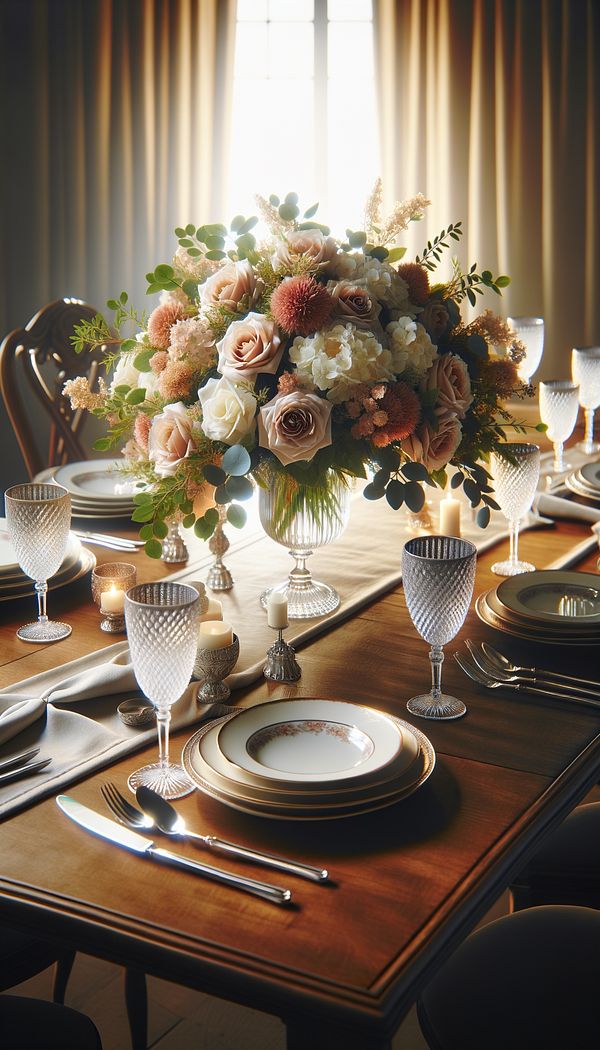What is a Centerpiece?
A centerpiece is an item or group of items placed at the center of a table or surface to serve as the focal point of a setting.
Description
In the realm of interior design, a centerpiece isn't merely a decorative item; it encapsulates the theme or style of a room, an event, or a gathering. It's strategically placed at the center of a table or any other surface to draw attention and create a cohesive look. Centerpieces can vary vastly in complexity, from simple single objects like a vase or candle, to elaborate arrangements including flowers, fruits, candles, and more.
The choice of centerpiece can influence the ambiance of a space significantly, making it warm and inviting, or sophisticated and formal, depending on the elements used. It's not confined to dining tables alone; centerpieces can adorn coffee tables, sideboards, and even reception counters in commercial settings.
Thus, the art of choosing or crafting a centerpiece involves an understanding of scale, proportion, and harmony within the space it occupies. It also opens up an opportunity for personal expression, allowing the creator to infuse the setting with their unique aesthetic and cultural preferences.
Usage
During a wedding reception, a floral arrangement placed at the center of each guest table serves as a centerpiece, anchoring the table setting and enhancing the overall decor theme. In a more casual setting, a centerpiece might consist of a collection of candles of varying heights, placed on a decorative tray in the living room to create a cozy atmosphere.
FAQs
-
How do I choose the right size for a centerpiece?
The right size for a centerpiece depends on the size of the table and the height of the ceiling. A good rule of thumb is to maintain a balanced scale and proportion, ensuring the centerpiece complements the table without overwhelming it or obstructing views across it.
-
Can centerpieces only be used during special occasions?
No, centerpieces can be used to enhance the decor of any room at any time. They're not limited to special occasions and can add visual interest to your everyday living space.
-
Are DIY centerpieces a good idea?
Absolutely! DIY centerpieces are a great way to personalize your space and can be a fun, creative project. They allow for customization to perfectly match your decor and can be a cost-effective alternative to store-bought options. However, consider the balance and harmony of the arrangement to ensure it fits within your overall design theme.
Practical Application
When designing or selecting a centerpiece, consider the other elements in the room, such as the table setting, lighting, and surrounding decor. Aim for the centerpiece to complement these elements rather than compete with them. Seasonality can also guide your choice, using fresh flowers in spring or pine cones and candles during the winter holidays, for example. Remember, the key is to strike a balance that enhances the atmosphere without overpowering the space.
-
Design Styles478 articles
-
Furniture Types599 articles
-
Decorative Objects240 articles
-
Decorating Principles & Elements330 articles
-
Color & Patterns154 articles
-
Corrected Grain LeatherCorrected grain leather is a type of leather that has been sanded, buffed, or processed to minimize imperfections.
-
Artisan StyleArtisan Style refers to a design aesthetic that emphasizes handcrafted elements and materials.
-
Coil SpringsCoil springs are components used in the construction of seating and mattresses to offer support and comfort.
-
Modular SeatingModular seating is a flexible furniture solution composed of multiple independent pieces that can be arranged and rearranged to suit different spaces and needs.
-
Scatter-Back SofaA scatter-back sofa is a style of sofa characterized by multiple loose cushions arranged across its back.
